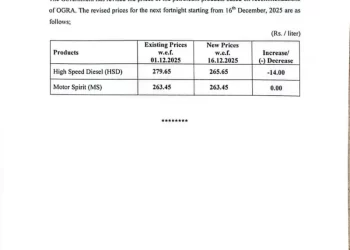Pakistan’s headline inflation is expected to decelerate further in the next two months (September-October) and may hover around 8-9%, the Finance Division projected on Friday.
In its ‘Monthly Economic Update and Outlook’, the ministry said the Consumer Price Index (CPI) has receded to single digits, lowest in 34 months in August 2024, and anticipated to decrease further in the near term.
In August, CPI was recorded at 9.6% on year-on-year (YoY) basis compared to 27.4% in the same month last year, according to the outlook report.
Meanwhile, in its monthly report, the Finance ministry said Pakistan’s economy indicated positive developments during the first two months of FY2025.
“Inflation has dropped to single digits, industrial output has increased, and large exporting sectors have witnessed growth, reflecting an optimistic outlook for exports.
“The current account deficit contracted, while the fiscal sector remained resilient, mainly attributed to prudent measures,” the report stated.
“This trajectory is expected to continue in the coming months.”
Large-scale manufacturing
Following a phase of decline, the ministry said large-scale manufacturing (LSM) was regaining its footing and major exporting sectors showed readiness to scale up production.
LSM output increased by 2.4% in July 2024, rebounding from a contraction of 5.4% in July 2023, reflecting “improved market conditions and policy support”.
During the period, according to the report, 14 out of 22 sectors witnessed positive growth which included, textile, food, beverages, wearing apparel, coke and petroleum products, chemicals, automobiles and paper & board.
Textile, with the largest weight in LSM (18.2), turned positive after 24 months.
“This recovery is expected to be bolstered by a favorable external environment, a stable exchange rate, and declining inflationary pressures,” it said.
Agriculture
For agriculture, the outlook of Kharif 2024 production, weather being critical factor will pave the way for productivity, the ministry said.
During FY2025 (July-August), imports of agricultural machinery and implements increased by 105.6% to $17.6 million compared to the same period last year, as per the report.
Aurangzeb says agriculture, IT key economic drivers 839
“This growing commitment to mechanisation and innovation in farming practices is expected to enhance yield in coming months.”
Urea offtake during Kharif 2024 (Apr-Aug) recorded at 2,381 thousand tonnes, 13.6% less than Kharif 2023 and DAP offtake decreased by 21.9% compared to Kharif2023.
“The decline may be attributed to late sowing of Kharif crops as a result of climate change, lower prices of wheat and reduction in cotton acreage,” the report said.
External front
On the external front, the finance ministry expects that exports and imports will observe an increase in momentum.
In September 2024, the exports are likely to remain within range of $2.5-3.0 billion, imports $4.5-5.0 billion and workers’ remittances $2.7-3.2 billion.
Pakistan’s headline inflation is expected to decelerate further in the next two months (September-October) and may hover around 8-9%, the Finance Division projected on Friday.
In its ‘Monthly Economic Update and Outlook’, the ministry said the Consumer Price Index (CPI) has receded to single digits, lowest in 34 months in August 2024, and anticipated to decrease further in the near term.
In August, CPI was recorded at 9.6% on year-on-year (YoY) basis compared to 27.4% in the same month last year, according to the outlook report.
Meanwhile, in its monthly report, the Finance ministry said Pakistan’s economy indicated positive developments during the first two months of FY2025.
“Inflation has dropped to single digits, industrial output has increased, and large exporting sectors have witnessed growth, reflecting an optimistic outlook for exports.
“The current account deficit contracted, while the fiscal sector remained resilient, mainly attributed to prudent measures,” the report stated.
“This trajectory is expected to continue in the coming months.”
Large-scale manufacturing
Following a phase of decline, the ministry said large-scale manufacturing (LSM) was regaining its footing and major exporting sectors showed readiness to scale up production.
LSM output increased by 2.4% in July 2024, rebounding from a contraction of 5.4% in July 2023, reflecting “improved market conditions and policy support”.
During the period, according to the report, 14 out of 22 sectors witnessed positive growth which included, textile, food, beverages, wearing apparel, coke and petroleum products, chemicals, automobiles and paper & board.
Textile, with the largest weight in LSM (18.2), turned positive after 24 months.
“This recovery is expected to be bolstered by a favorable external environment, a stable exchange rate, and declining inflationary pressures,” it said.
Agriculture
For agriculture, the outlook of Kharif 2024 production, weather being critical factor will pave the way for productivity, the ministry said.
During FY2025 (July-August), imports of agricultural machinery and implements increased by 105.6% to $17.6 million compared to the same period last year, as per the report.
Aurangzeb says agriculture, IT key economic drivers 839
“This growing commitment to mechanisation and innovation in farming practices is expected to enhance yield in coming months.”
Urea offtake during Kharif 2024 (Apr-Aug) recorded at 2,381 thousand tonnes, 13.6% less than Kharif 2023 and DAP offtake decreased by 21.9% compared to Kharif2023.
“The decline may be attributed to late sowing of Kharif crops as a result of climate change, lower prices of wheat and reduction in cotton acreage,” the report said.
External front
On the external front, the finance ministry expects that exports and imports will observe an increase in momentum.
In September 2024, the exports are likely to remain within range of $2.5-3.0 billion, imports $4.5-5.0 billion and workers’ remittances $2.7-3.2 billion.









